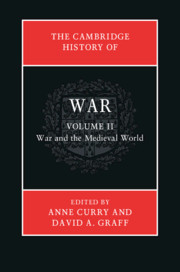Book contents
- The Cambridge History of War
- The Cambridge History of War
- Copyright page
- Contents
- Illustrations
- Maps
- Notes on contributors
- Introduction to volume II
- Part I Foundations, c.600–1000 ce
- Part II Interactions, c.1000–1300 ce
- Part III Nations and Formations, c.1300–1500 ce
- 13 Western Europe, 1300–1500
- 14 Warfare and Italian states, 1300–1500
- 15 The reconquest and the Spanish monarchies
- 16 The Byzantine empire and the Balkans, 1204–1453
- 17 Ottoman expansion and military power, 1300–1453
- 18 India, c.1200–c.1500
- 19 Southeast Asia, 1300–1540
- 20 Japan, 1200–1550
- 21 The Americas
- Part IV Comparisons: Cross-Cultural Analysis
- Select bibliography
- Index
17 - Ottoman expansion and military power, 1300–1453
from Part III - Nations and Formations, c.1300–1500 ce
Published online by Cambridge University Press: 25 September 2020
- The Cambridge History of War
- The Cambridge History of War
- Copyright page
- Contents
- Illustrations
- Maps
- Notes on contributors
- Introduction to volume II
- Part I Foundations, c.600–1000 ce
- Part II Interactions, c.1000–1300 ce
- Part III Nations and Formations, c.1300–1500 ce
- 13 Western Europe, 1300–1500
- 14 Warfare and Italian states, 1300–1500
- 15 The reconquest and the Spanish monarchies
- 16 The Byzantine empire and the Balkans, 1204–1453
- 17 Ottoman expansion and military power, 1300–1453
- 18 India, c.1200–c.1500
- 19 Southeast Asia, 1300–1540
- 20 Japan, 1200–1550
- 21 The Americas
- Part IV Comparisons: Cross-Cultural Analysis
- Select bibliography
- Index
Summary
The Ottoman empire is named after Osman(d.1324), the eponymous founder of the dynasty, whose name came to be rendered in English as Ottoman. Osman was a Turkish frontier lord – beg in Turkish – who commanded a band of semi-nomadic fighters at the beginning of the fourteenth century in northwestern Asia Minor (Anatolia), known at the time to Turks, Persians, and Arabs as the land of Rum (Rome); that is, the land of the Eastern Roman Empire. Osman Beg was but one of many Turkish lords who carved out their respective principalities in western and central Asia Minor, profiting from the power vacuum caused by the Mongols’ destruction of the Seljuq sultanate of Rum in 1243.
- Type
- Chapter
- Information
- The Cambridge History of War , pp. 449 - 469Publisher: Cambridge University PressPrint publication year: 2020
- 1
- Cited by

